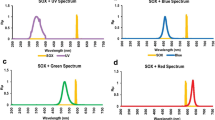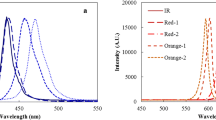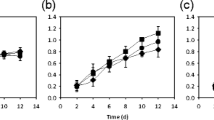Abstract
Objectives
To assess the effects of light intensity and quality on the growth and phycobiliproteins (PBP) accumulation in Nostoc sphaeroides Kützing (N. sphaeroides).
Results
Dry weights, dry matter, protein, chlorophyll and PBP contents were higher under 90 μmol m−2 s−1 than under other intensities (both higher and lower). Phycocyanin and allophycocyanin increased with light intensity while phycoerythrin decreased. Fresh weights, protein and PBP contents increased at the highest rates under blue light. Red light resulted in higher values of dry matter, phycocyanin and chlorophyll a.
Conclusion
White light at 90 μmol m−2 s−1 or blue light 30 μmol m−2 s−1 were optimal for the growth and phycobiliprotein accumulation in N. sphaeroides.






Similar content being viewed by others
References
Borowitzka MA (1992) Algal biotechnology products and processes—matching science and economics. J Appl Phycol 4:267–279
Chen Z, Juneau P, Qiu B (2007) Effects of three pesticides on the growth, photosynthesis and photoinhibition of the edible cyanobacterium Ge-Xian-Mi (Nostoc). Aquat Toxicol 81:256–265
Chen CY, Kao PC, Tsai CJ, Lee DJ, Chang JS (2013) Engineering strategies for simultaneous enhancement of C-phycocyanin production and CO2 fixation with Spirulina platensis. Bioresour Technol 145:307–312
Damiani MC, Popovich CA, Constenla D, Leonardi PI (2010) Lipid analysis in Haematococcus pluvialis to assess its potential use as a biodiesel feedstock. Bioresour Technol 101:3801–3807
Deng Z, Hu Q, Lu F, Liu G, Hu Z (2008) Colony development and physiological characterization of the edible blue-green alga, Nostoc sphaeroides (Nostocaceae, Cyanophyta). Prog Nat Sci 18:1475–1483
Dodds WK, Gudder DA, Mollenhauer D (1995) The ecology of Nostoc. J Phycol 31:2–18
Feng P, Deng Z, Hu Z, Fan L (2011) Lipid accumulation and growth of Chlorella zofingiensis in flat plate photobioreactors outdoors. Bioresour Technol 102:10577–10584
Gao K, Ai H (2004) Relationship of growth and photosynthesis with colony size in an edible Cyanobacterium, Ge-Xian-Mi Nostoc (Cyanophyceae) 1. J Appl Phycol 40:523–526
Garnier F, Dubacq JP, Thomas JC (1994) Evidence for a transient association of new proteins with the Spirulina maxima phycobilisome in relation to light intensity. Plant Physiol 106:747–754
Grossman AR (2003) A molecular understanding of complementary chromatic adaptation. Photosynth Res 76:207–215
Grossman AR, Bhaya D, He Q (2001) Tracking the light environment by cyanobacteria and the dynamic nature of light harvesting. J Biol Chem 276:11449–11452
Huang Z, Liu Y, Paulsen BS, Klaveness D (1998) Studies on polysaccharides from three edible species of Nostoc (Cyanobacteria) with different colony morphologies: comparison of monosaccharide compositions and viscosities of polysaccharides from field colonies and suspension cultures. J Appl Phycol 34:962–968
Kehoe DM (2010) Chromatic adaptation and the evolution of light color sensing in cyanobacteria. Proc Natl Acad Sci USA 107:9029–9030
Nomsawai P, de Marsac NT, Thomas JC, Tanticharoen M, Cheevadhanarak S (1999) Light regulation of phycobilisome structure and gene expression in Spirulina platensis C1 (Arthrospira sp. PCC 9438). Plant Cell Physiol 40:1194–1202
Park YK, Rasmussen HE, Ehlers SJ, Blobaum KR, Lu F, Schlegal VL, Carr TP, Lee JY (2008) Repression of proinflammatory gene expression by lipid extract of Nostoc commune var sphaeroides Kutzing, a blue-green alga, via inhibition of nuclear factor-kappaB in RAW 264.7 macrophages. Nutr Res 28:83–91
Qiu B, Liu J, Liu Z, Liu S (2002) Distribution and ecology of the edible cyanobacterium Ge-Xian-Mi (Nostoc) in rice fields of Hefeng County in China. J Appl Phycol 14:423–429
Rasmussen HE, Blobaum KR, Park YK, Ehlers SJ, Lu F, Lee JY (2008) Lipid extract of Nostoc commune var. sphaeroides Kutzing, a blue-green alga, inhibits the activation of sterol regulatory element binding proteins in HepG2 cells. J Nutr 138:476–481
Rasmussen HE, Blobaum KR, Jesch ED, Ku CS, Park YK, Lu F, Carr TP, Lee JY (2009) Hypocholesterolemic effect of Nostoc commune var. sphaeroides Kutzing, an edible blue-green alga. Eur J Clin Nutr 48:387–394
Raven JA, Kübler JE (2002) New light on the scaling of metabolic rate with the size of algae. J Phycol 38:11–16
Scherer S, Zhong ZP (1991) Desiccation independence of terrestrial Nostoc commune ecotypes (cyanobacteria). Microbial Ecol 22:271–283
Spolaore P, Joannis-Cassan C, Duran E, Isambert A (2006) Commercial applications of microalgae. J Biosci Bioeng 101:87–96
Tang J, Hu ZY, Chen XW (2007) Free radical scavenging and antioxidant enzymes activation of polysaccharide extract from Nostoc sphaeroides. Am J Chin Med 35:887–896
Tyystjärvi E, Aro EM (1996) The rate constant of photoinhibition, measured in lincomycin-treated leaves, is directly proportional to light intensity. Proc Natl Acad Sci USA 93:2213–2218
Wang XP, Xie BJ, Pan SY, Chen DW (2005) The studies on in vitro anti-oxygen free radical of N. sphaeroides Kützing phycoerythrin. Food Sci 26:404–407
Wang XP, Xie BJ, Pan SY, Chen DW, Zhao LX (2007) Study on antioxidation activities of phycocyanin from N. sphaeroides Kützing. Food Sci 28:458–461
Yamanaka G, Glazer AN (1980) Dynamic aspects of phycobilisome structure. Arch Microbiol 124:39–47
Acknowledgments
We are grateful to the editor and the anonymous referees for their expert assistance and comments on this manuscript. This work was supported by the National Natural Science Foundation of China (Grant No. 31123001).
Conflict of interest
The authors declare that they have no conflict of interests.
Author information
Authors and Affiliations
Corresponding author
Rights and permissions
About this article
Cite this article
Ma, R., Lu, F., Bi, Y. et al. Effects of light intensity and quality on phycobiliprotein accumulation in the cyanobacterium Nostoc sphaeroides Kützing. Biotechnol Lett 37, 1663–1669 (2015). https://doi.org/10.1007/s10529-015-1831-3
Received:
Accepted:
Published:
Issue Date:
DOI: https://doi.org/10.1007/s10529-015-1831-3




